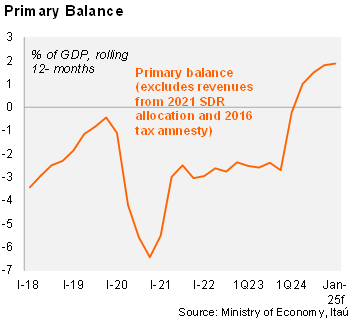As expected, Argentina’s treasury ran a primary surplus in January of ARS 2434.9 billion, significantly above the surplus of ARS 2010.7 billion posted one year earlier. The nominal fiscal balance also posted a surplus of ARS 599.8 billion, above the surplus of ARS 518.4 billion in January 2024. As a result, the primary balance reached an estimated surplus of 0.3% of GDP in the first month of the year, while the nominal balance stood at +0.1% of GDP.

Real tax revenues declined in the quarter ended in January, but at a slower pace due to the recovery of activity at the margin. Total real revenues decreased by 1.3% yoy in the period after falling 2.3% in 4Q24. Tax collection rose by 3.2% yoy in real terms in the period, after growing by 3.9% in 4Q24, but offset by the elimination of the so called “Impuesto País” on imports.
Strict control on expenditures continued at the start of 2025. Primary expenditures declined by 10.6% yoy in real terms in the quarter ended in January, after falling 22.1% yoy in 4Q24. Energy subsidies fell by 29.0% yoy, compared with a drop of 29.6% in 4Q24, while payrolls decreased by 16.0% yoy (-24.3% in 4Q24). Capital expenditures were down sharply by 59.5% yoy (-69.7% in 4Q24) due to the freeze on public works, while transfers to provinces plunged by 56.8% yoy. Pension payments were up 16.8% yoy (+3.2% in 4Q24) due to a new adjustment formula based on inflation plus a one-time bonus.
Our Take: We expect a primary surplus of 1.3% of GDP in 2025, consistent with a balanced nominal budget, both in line with the 2025 budget bill. The government's strong commitment to the fiscal framework as the main anchor of the stabilization program supports our call. Fiscal data for February will be published on March 17.
